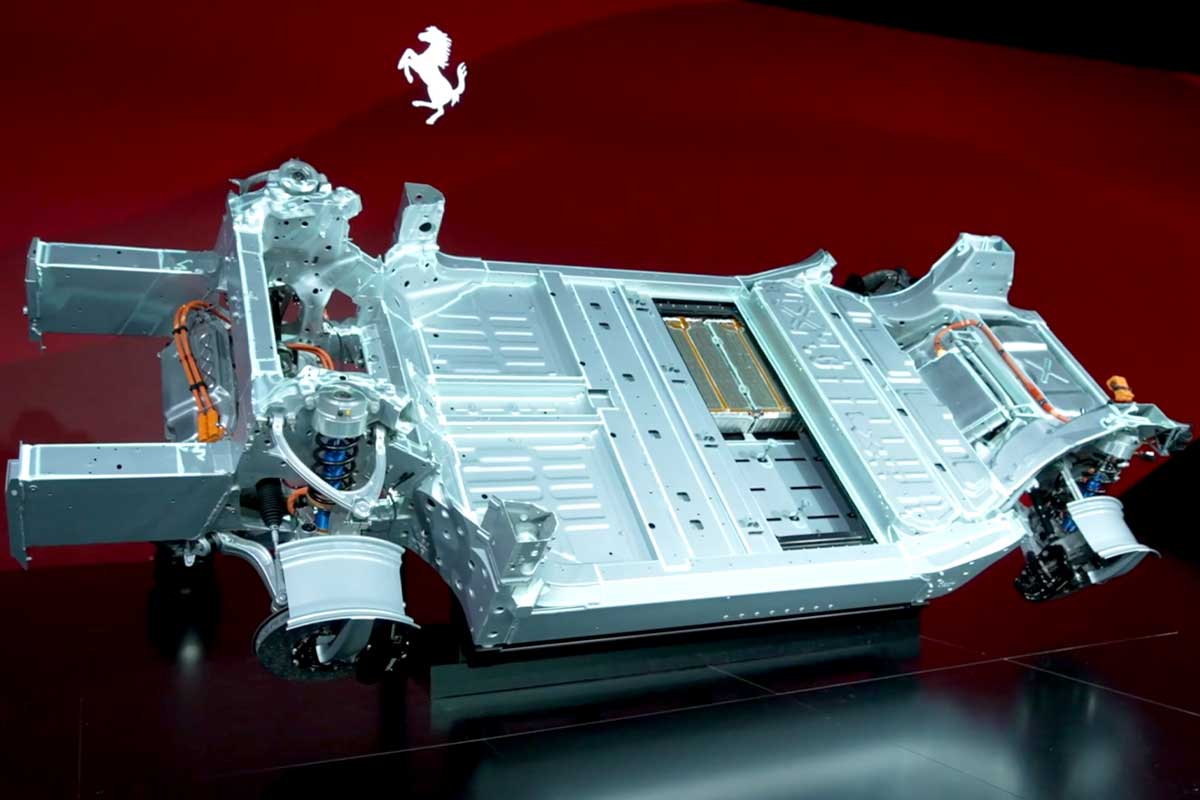
Ferrari has just lifted the veil on the technical specifications of its future Elettrica 4 doors, 4 engines, over 1,000 hp, 0 to 100 km/h in 2.5 seconds and a top speed of 310 km/h. With its 122 kWh battery, the Italian automaker promises a range of over 530 km, a recharging capacity of up to 350 kW, and a well-engineered chassis to compensate for an estimated weight of 2,300 kg. Maranello insists that this first electric Ferrari will be as efficient in corners as it is in a straight line, while remaining true to the brand's sporting DNA.
But these announcements leave some specialists skeptical. We interviewed Quentin Laporte, an engineer specializing in electrified powertrains, who analyzes Ferrari's technical choices with a critical eye.
"I have to admit that I find it hard to see how what they're proposing here is unique. For the moment, the Chinese and Germans are leading the way, technically speaking, and I don't think they stand a chance if they want to compete on sheer power: we'll have to find something else."
Batteries and fast charging: figures in decline
With its 122 kWh, the Ferrari Elettrica boasts an estimated energy density of 195 Wh/kg. "Not bad for a pack," notes Laporte, "but nothing revolutionary. According to Laporte, the recharging power of 350 kW doesn't impress either:
"350 kW with 120 kWh is like 175 kW with 60 kWh: it doesn't break any records. Even the 530 km range isn't extraordinary."
Competitors such as the BYD Han L claim a peak power of 1,360 kW thanks to a 1000V pack.
Battery reparability: a false promise?
Ferrari insists on the future repairability of its 15-module pack. A promise that the engineer considers not very credible:
"The talk about reparability is bullshit. We had the same thing at Renault. In practice, if you're serious, you replace cells individually."
Comparison with market benchmarks
For Quentin Laporte, the real benchmark remains the Lucid Air Sapphire: 1,234 hp, 2 seconds from 0-100 km/h, 330 km/h top speed and 687 km range with a smaller battery.
"The Ferrari seems relatively light, about 120 kg lighter than the Lucid, but it's still 500 kg more than a GTC4 Lusso and 300 kg more than a Purosangue. That's still a lot."
Fun to drive, but is it enough?
Ferrari promises a playful driving experience, with paddles on the steering wheel to adjust regeneration and torque, and specific work on the artificial sound of the engines. A commendable effort, but not necessarily enough, according to the engineer:
"The Ioniq 5 N is expensive... The only important thing is to do something good. And a bit original! Ferrari, you're not Toyota!"
The Ferrari challenge
In short, Ferrari is entering an ultra-competitive field where the Germans (Mercedes-AMG GT XX) and the Chinese (BYD, Xiaomi, Yangwang) are already at the forefront of technology.
"They won't be able to distinguish themselves technically, because everyone is at the same state of the art. So we'll have to innovate elsewhere," concludes Quentin Laporte.
An uncompromising observation: Ferrari may be able to rely on its chassis expertise and the emotion generated by its badge. But in the world of electric cars, the cards have been reshuffled and Maranello will have to convince beyond the numbers.
A beautiful design, a high-flying chassis and a luxurious interior are what make this Ferrari so attractive, even if its technical specifications are not the best.
Make sure that the design is not too close to the Purosangue, otherwise people will say that Ferrari is copying Xiaomi.
Perhaps, but this engineer forgets one thing: for the customer who can put such sums of money into this style of vehicle, and for whom "appearance" or "did you see me" is very important, he will always choose the most prestigious badge, in our case here, he will always choose an electric Ferrari or not over a vulgar Mercedes, even if said Ferrari offers nothing more than the Mercedes!
Ciertamente el mencionado ingeniero no es simpatizante de la marca Ferrari. Un ignorante en lo que respecta a prestigio e historia de lo que significa una Ferrari. Podrá haber otros pero mal que le pese a este señor el cavallino es el cavallino. Patético personaje
This "engineer" is making a mockery of our profession. Indeed, the miserable power density calculations he makes are no more than an element of comparison, but if he were at all serious, he'd wait until he had more details on the architecture of the electrical chain and the technological choices made by Ferrari.
In short, an incompetent person, to put it mildly, who criticizes figures without understanding them...